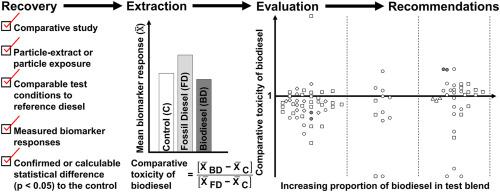Atmospheric Environment ( IF 4.2 ) Pub Date : 2021-06-25 , DOI: 10.1016/j.atmosenv.2021.118570 Daniel Southern , Paul Hellier , Midhat Talibi , Martin O. Leonard , Nicos Ladommatos

|
Biofuels may reduce road transport carbon intensity; however, it is uncertain whether displacing fossil diesel would alter the engine-derived particulate toxicity. The primary objective of this work was to determine whether there is a fuel effect on the comparative in vitro toxicity of biodiesel exhaust particulates relative to those from fossil diesel. A secondary aim was to determine qualitatively whether the observed outcome is related to the organic phase, namely Polycyclic Aromatic Hydrocarbons (PAHs). In vitro and acellular exposure studies were recovered from a literature survey following the PRISMA framework. Biological responses attributable to biodiesel and paired fossil diesel particles, including particle-extracts were selected. To qualify for inclusion, either of the paired responses must differ statistically significantly (p < 0.05) from the control or each other. Paired responses were assigned to one-of-five categories which best represents the pathophysiological role of the biomarker: inflammation, oxidative stress, cytotoxicity, genotoxicity and mutagenicity. Biodiesel reduced particle toxicity in two-thirds of paired responses, however, there were large differences between biodiesels for category-specific biomarkers. Particles derived from Rapeseed oil Methyl Ester (RME) were less inflammatory, whereas Soybean oil Methyl Ester (SME) particles were more inflammatory than fossil diesel on average. Conversely, SME reduced oxidative stress while few trends emerged for mutagenicity and genotoxicity. The largest fuel effect was observed for cytotoxicity: Waste Cooking Oil Methyl Ester (WCOME) increased and Palm oil Methyl Ester (PME) decreased particle cytotoxicity. Particle-phase PAH emissions compiled on a mass-of-soot basis also followed this trend, however, literature focusing on both these aspects is limited; careful consideration of fuel composition and use of normal primary human cell types and omics technologies, could resolve this open question. This assessment systematically compares biological responses from particulate only exposure, with co-exposure necessarily excluded due to an absence of understanding of how gaseous components modify particulate toxicity.
中文翻译:

重新评估生物柴油燃烧产生的颗粒的毒性:体外研究的定量分析
生物燃料可降低道路运输碳强度;然而,目前尚不确定替代化石柴油是否会改变发动机衍生的颗粒毒性。这项工作的主要目的是确定是否对体外比较有燃料影响生物柴油废气颗粒相对于化石柴油的毒性。第二个目的是定性确定观察到的结果是否与有机相有关,即多环芳烃 (PAH)。体外和无细胞暴露研究是从遵循 PRISMA 框架的文献调查中恢复的。选择了归因于生物柴油和配对化石柴油颗粒(包括颗粒提取物)的生物反应。要符合纳入条件,配对响应中的任何一个都必须与对照或彼此之间具有显着统计学差异 (p < 0.05)。配对反应被分配到最能代表生物标志物病理生理作用的五个类别之一:炎症、氧化应激、细胞毒性、基因毒性和致突变性。生物柴油在三分之二的配对反应中降低了颗粒毒性,但是,生物柴油之间在类别特异性生物标志物方面存在很大差异。平均而言,源自菜籽油甲酯 (RME) 的颗粒的炎症性较低,而豆油甲酯 (SME) 颗粒的炎症性平均高于化石柴油。相反,SME 减少了氧化应激,而致突变性和遗传毒性的趋势很少。在细胞毒性方面观察到最大的燃料效应:废食用油甲酯 (WCOME) 增加,棕榈油甲酯 (PME) 降低颗粒细胞毒性。以烟尘质量为基础编制的颗粒相 PAH 排放也遵循这一趋势,但是,关注这两个方面的文献有限;仔细考虑燃料成分以及使用正常的原代人类细胞类型和组学技术,可以解决这个悬而未决的问题。该评估系统地比较了仅暴露于颗粒物的生物反应,由于不了解气体成分如何改变颗粒物毒性,因此必然排除共同暴露。









































 京公网安备 11010802027423号
京公网安备 11010802027423号